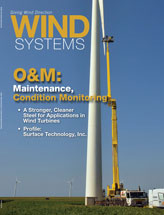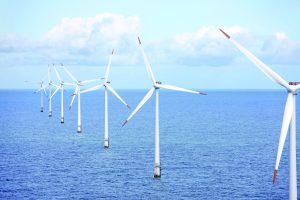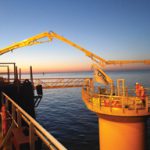High-performance steel is used for fasteners to hold wind turbines to the ground, to assemble the modules of the tower, and to attach the blades. Steel bar is used to make the anchor chains in offshore applications, while steel tube and bar is used for cylinders, pistons, and pumps that control slewing and pitch. Tube, bar, and rolled rings are used for bearings, gears, shafts, and couplings.
These components are expected to perform continuously in remote locations and in some of the harshest environments. They have to cope with the power and unpredictability of the wind, which creates high, multi-directional transient loads as wind speed and direction change, in addition to the massive cost of downtime if components fail.
Steel of very high cleanliness with a consistent microstructure and high resistance to fatigue and impact can be produced by advanced re-melting techniques, but the lengthy and complex processes involved — decarburization, vacuum induction melting, and vacuum arc re-melting — are expensive and have limited availability. However, advances in ladle metallurgy and testing procedures are now making it possible to produce low alloy air-melt steels that can compete with re-melt steels in terms of fatigue strength. With fatigue accounting for approximately 90 percent of all mechanical service failures, the potential benefits to the wind power industry are considerable.
The Influence of Inclusions
It is well-known that the intrinsic fatigue limit of steel increases with the strength or hardness of the steel by a factor of approximately 1.6. However, as the strength of the steel increases, the obtained fatigue limit is increasingly lower than the intrinsic limit. This is the result of material defects, such as inclusions, acting as stress raisers and promoting fatigue crack initiation (see Figure 1).

In rotating beam fatigue tests, inclusions found at the sites where fatigue was initiated were analyzed for chemical composition, size, and location. The results were used to construct the empirical curves as shown in Figure 2. This shows that higher-strength steels are more affected by the presence of inclusions. Steel with an intrinsic strength of 640 MPa (400 HV) will not show any further improvement in fatigue strength once oxide inclusions are less than 20 µm. However, there is much greater potential for higher-strength steels to be improved and to get closer to the steel’s intrinsic strength. For a steel with an intrinsic strength of 1120 MPa (700 HV), the critical inclusion size is just 6 µm.

Loading Direction and Volume
Steel is typically anisotropic, so its fatigue strength will vary depending on the loading axis. This is exaggerated by the rolling process, during which inclusions are crushed and elongated in the direction of rolling (see Figure 3). The loaded volume also influences the likelihood of finding an inclusion of critical size, therefore, a large volume that’s loaded transversely to the rolling direction has a much higher probability of failure (see Figure 4).

Using current technologies, data can be collected on a material’s morphology, chemical composition, and the position of inclusions. This data can be used to calculate the probability of finding inclusions of a certain size. Using the empirical relationship established in Figure 2, it is then possible to convert the inclusion size into the stress required to cause a fatigue failure.

Using this methodology, analysis of sulphide inclusions in a 100 m3 volume of high sulphur 50CrMo4 steel, loaded in the direction of rolling, shows a 5-percent failure rate at a stress of 800 MPa. When the loading is transverse to the rolling direction, 5 percent will fail at a stress of 200 MPa.
Isotropic Quality Process
This ability to quantify the inclusion population in standard steels has enabled Ovako AB, a leading European producer of engineering steel for the bearing, transport, and manufacturing industries, to make dramatic improvements in the steel-making process and to introduce new processes that are capable of producing steels that can match re-melt quality.
The isotropic quality (IQ) process is based on Ovako’s standard ingot casting process for the production of bearing quality steel, and it has two key objectives — to improve structural fatigue properties and to produce a more isotropic steel.
The key differences in the process are in the selection of scrap and raw materials, increased desulphurization (down below 20 ppm), increased degassing time, the use of argon shrouding during ingot casting, increased soaking time to improve homogenization, and increased crop-off mass in billet production to reduce segregation and minimize the number of macro inclusions.
The IQ process does not remove the oxide inclusions, but based on the influence of inclusion size on fatigue, it creates a much finer distribution so that the number of inclusions below 4 µm is higher than in conventionally produced steel (see Figure 5). Inclusions that are smaller than 4 µm would require a very high stress to cause a fatigue failure (close to the intrinsic strength of the steel itself).

In rotating beam fatigue tests, the fatigue life of IQ-processed steel was found to increase by a factor of 10 over conventionally processed steel. When compared to a 300M steel (a low-alloy steel of very high strength) produced through vacuum arc re-melting (VAR), the determined fatigue limit and the size of inclusions that initiated fatigue failures were almost identical (see Figure 6).

In order to measure improvements in isotropy, a conventionally produced 50CrMo4 steel was compared to an IQ-processed variant. In each case, billets were cross-rolled into a plate from which samples were machined, orientated both longitudinally and transversely to the initial rolling direction.
While the IQ-processed steel showed virtually no difference in fatigue limit between the longitudinal and transverse samples, the conventional steel could only achieve half the fatigue limit when loaded into the transverse direction.
Selection of suitable clean steel produced through advanced ladle technology offers the desired fatigue strength for use in wind turbine applications. When making material selection for use in such demanding applications, detailed knowledge — not only of the magnitude of the applied stress, but also in loading direction and loaded volume — is crucial.



































